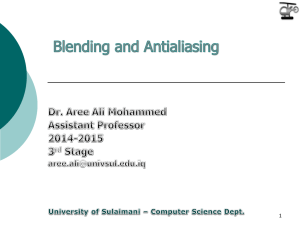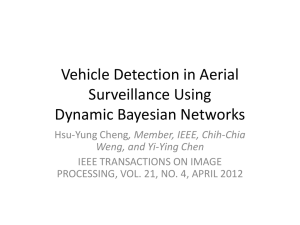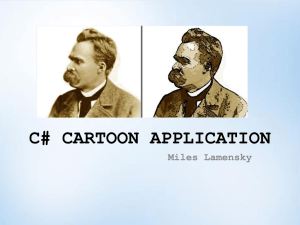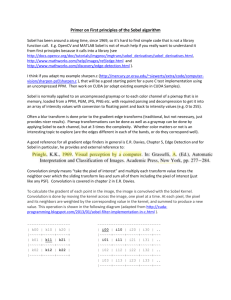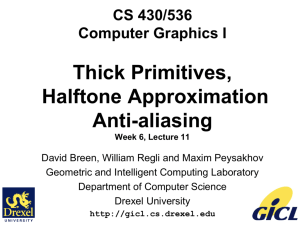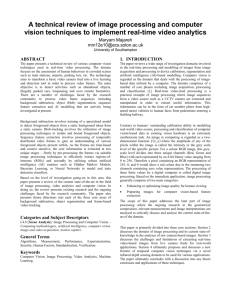Technical Lecture
advertisement
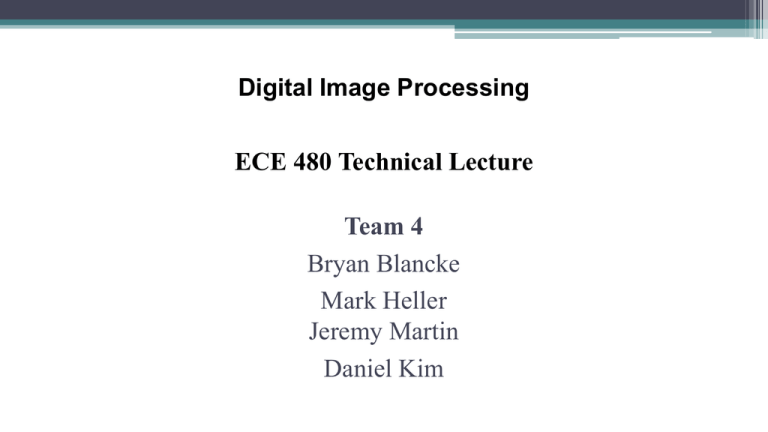
Digital Image Processing ECE 480 Technical Lecture Team 4 Bryan Blancke Mark Heller Jeremy Martin Daniel Kim Background What is digital image processing? Modification of digital data for improving the image qualities with the aid of computer Improvement of pictorial information for human interpretation The processing helps in maximising clarity, sharpness and details of features of interest towards information extraction and further analysis. i.e. edge detection, removal of noise. Applications Image enhancement & restoration Medical visualisation Law enforcement Industrial inspection Artistic effects Human computer interfaces Segmentation Segmentation is to subdivide an image into its component regions or objects. No single segmentation technique is perfect Segmentation (continued) There are two most common types of segmentation techniques: 1)Thresholding 2)Edge detection Edge Detection Motivation for edge detection. Produce a line drawing of a scene from an image of that scene. Important features can be extracted from the edges of an image (ex: corners,lines, curves). These features are used by higher-level computer vision algorithms (ex: recognition). Edge Detection (continued) Edge Models: can be modeled according to their intensity profiles a)Step Edge b) Ramp Edge c) Roof Edge Edge Detection (continued) There are four steps for edge detection: 1) Smoothing: Remove noise as much as possible. 2) Enhancement: Apply a filter to enhance the quality of edges in the original image (ex: sharpening,contrast) 3) Detection: Determine which edge pixels should be thrown as a noise or retained for edge detection. 4) Localization: Identify the location of an edge. Detection Methods - Prewitt vs. Sobel Edge detection filters Only difference is the coefficient. Sobel has better noise suppression Both fail when exposed to high level of noise (laplacian operator for a better solution) Example Example - Prewitt vs Sobel Prewitt Sobel Anisotropic diffusion • Used to remove noise from images without removing critical parts of the image • Noise exists in images and is created from outside signals such as radio waves and light exposure Diffused vs. Original Image Pixelation and Antialiasing • Pixelation occurs when a section of a high-resolution is displayed and the single-colored square elements become visible • To solve this problem, antialiasing is used Antialiasing • Aliasing is an effect that will cause signals to be indistinguishable (cannot be reconstructed). What does antialiasing mean? • Antialiasing is the minimization of distortion and a small-scale reconstruction of a part of an image Pixel Interpolation • A type of antialiasing, pixel interpolation will occur when zoomed on a specific piece of an image • Pixel interpolation smoothly blends the color of one pixel into the next Pixelization • Occasionally, pixelation can be beneficial. The act of intentional pixelation is called pixelization. • Pixelization will essentially reverse interpolate the pixels, and enlarge them to create a jagged image. • Useful for obscenities and anonymity Computer Vision • Vision Systems and Image Processing • Manufacturing Facilities ▫ Increases Speed of Production ▫ Automates Inspection of Products Methods of Vision Systems • • • • • • Image Acquisition Image Pre-processing Feature Extraction Detection/Segmentation High-Level Processing Decision Making Methods of Vision Systems • • • • • • Image Acquisition Image Pre-processing Feature Extraction Detection/Segmentation High-Level Processing Decision Making Object Identification • Differentiate Between Classes of Objects • Sort Objects Fault Detection • Image Data Scanned for Pre-determined Conditions Object Tracking • Determine Relative Position of Objects Optical Flow • Assumes Stationary Camera System • Estimates Motion and Acceleration of Objects • Motion Displayed as Vectors Egomotion • Motion Estimation of Camera System • Determines Position Relative to Surroundings • Creates 3D Computer Model of Observed Space Digital Image Processing Tasks Digital image processing is the only practical technology for: Statistical Classification Feature Extraction Graphical Projection Pattern Recognition Statistical Classification Identifying which set of sub categories new observations belong too based on sets of data whose category membership is known Explanatory Variables: Individual observations are analyzed into quantifiable properties Categories, ordinal, integer, or real value. Example: Digital Camera Color Array Filtering Bayer Filter is put over the cameras phosphate layer Interpolation: Processor guesses colors of each pixel based on nearby information Feature Extraction Involves simplifying the amount of resources required to describe a large set of data accurately Reduces processing by eliminating redundant and unnecessary data It is expected that feature sets will extract relevant information from input data to perform the desired task •Uses in image processing Edge Detection Points where image brightness changes sharply Curvature edge direction Cross-correlation of image between time lag Motion Detection Change of position relative to surroundings Thresholding Forms greyscale images Hough Transform Detects lines to estimate text Graphical Projection Process of projecting a three dimensional object onto a planar surface with mathematical computation Converts complex 3D objects into a 2D equivalent Computations involve Fourier Transforms and Hermite Functions Pattern Recognition Which features distinguish objects from others? Algorithms classify objects or clusters of an image Applications Face Recognition Fingerprint Identification Document Image Analysis 3D Object Recognition Robot Navigation Questions?
